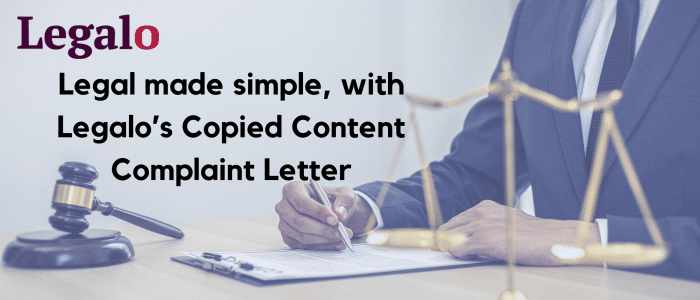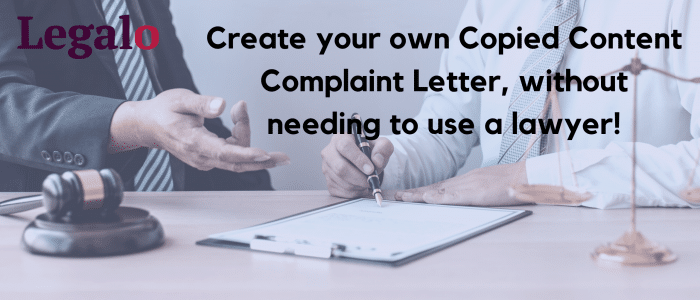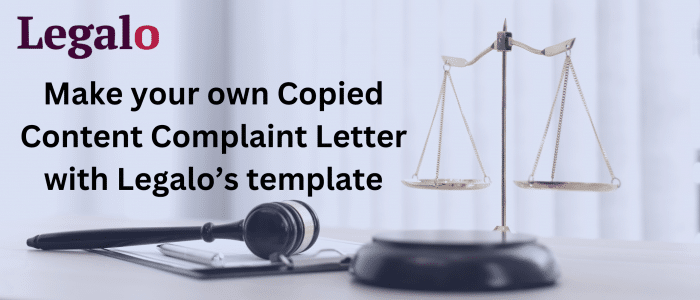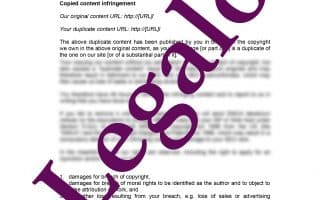Copied Content Complaint Letter
Our Copied Content Complaint Letter template:
- Brief and to the point
- Drafted by a specialist UK solicitor
- Guide includes practical self-help tips
- Quick & easy to edit

How Does It Work?
-
1. Download
-
2. Edit
-
3. Print
-
4. Sign
Have you ever been surfing the web and come upon your content on someone else’s website? If you have, then you are going to want to use the Copied Content Complaint Letter. This copyright infringement letter template is the ideal way to take care of the problem of someone using your material without permission. Besides being bad for your website business, you also run the risk of being hit for duplicate content by a search engine. You could be the one being penalised, when it is the other website that should be. You will want to send this Copied Content Complaint Letter to demand that the copied content is removed from the other website immediately.
When you have this Copied Content Complaint Letter on hand, it will save you from having to spend time and money on a solicitor in order to sort out a copyright violation.

Using our Copied Content Complaint Letter template
It could not be easier for you to use our letter template. It comes with a guide to filling it in. Also you will be able to produce your final letter in just a few minutes.
By using our letter template, you will be able to send a hard-hitting message to the person infringing your copyright. Generally this will be enough to get the result you want. If not, we also have a DMCA Take Down Notice template, which you can send as the next step to the infringer’s host/ISP and also to Google, other search engines and YouTube (if the infringing content is a YouTube hosted video).
Copyright laws
For copyright infringement to exist under UK law, the infringement has to be of a substantial part of the copyright work. So if one of your Webpages (or the article published there) is considered on its own to be one copyright work, then the infringer would have to have copied a substantial part of it for it to constitute copyright infringement. For example, if only a couple of paragraphs of a fairly lengthy article were copied in whole but nothing else was, this might not be considered to be a substantial part (NB the legal test is both qualitative and quantitative). However if the whole of a shorter article were copied, then this would clearly be a substantial part, even though the words copied might be fewer than, or the same number as, the couple of paragraphs copied from the long article in the previous example.
It is a good idea on your website to make it clear that you are claiming copyright in the contents of your website. One way of doing this is by adding the copyright symbol, i.e. ©, and the business’s or individual’s name and the year to the footer at the bottom of every page of your site. In the UK you do not need to register copyright (indeed, you cannot register it here).
In your terms of use of your website, you can also:
- make it clear that you claim copyright ownership in the whole of the contents of your website, and
- you can set out what viewers can and cannot do with your content.
If you need a set of terms of use of your website to publish on your website, then Legalo has such a template for you.
Dealing with copyright infringement
Because information on the Internet is so accessible, it will be up to you to:
- watch out for copied content, and
- actively search for it on a regular basis.
Since outsourcing content for website pages is quite common, it is possible that the owner of the infringing website may not even realise that the content a third party produced for them was a copy from your site.
Once they receive your Copied Content Complaint Letter, most website operators are willing to remove it from their website. They know that the search engines are watching. They don’t want to jeopardise their ratings by their ISP or Google forcibly removing it after you send them a DMCA complaint letter (for which we also have a template).
Copied content comes under the law of copyright. It ultimately gives you a remedy through the courts if the owner of the infringing website does not correct it, following your sending the letter.
When you send this letter you have legal proof that:
- you notified the website that it was using copied content,
- gave them time to comply, and
- asked them to make amends.
If they refuse to remove it or simply ignore you, you then have something to take to the court. However, a much quicker and cheaper alternative is to send a DMCA complaint letter to the offender’s ISP and to Google to ask them to take down the duplicate content.
Gather the evidence of the breach at this stage. Take screenshots of the offending pages that clearly show your text and the offending website’s address. Save them in case the owner alters or removes them later. This is in case you need them if you need to enforce the matter, e.g. by giving further evidence to the court, Google or an ISP.
What if they don’t comply after sending this letter?
Give them a few days to react. If they dispute it or ignore you, then the best next step is to send a DMCA complaint letter to:
- their ISP, and
- to Google and other search engines (or YouTube if the infringing article is a YouTube-hosted video).
If you need a DMCA complaint letter, Legalo has such a template available. In nearly all cases, this letter, and the DMCA letter if required, will get you the result you need.
Taking anyone to court is a very slow and fairly expensive process in the UK. So you are best using it as a last resort if the DMCA letter does not get the result.
Clauses in this Copied Content Complaint Letter
The following text is an excerpt from our guide to this template, to help you complete it:
The idea is that you will print this letter on your letterhead notepaper (or the equivalent). You should include all your business’s usual contact details. Therefore delete the heading that refers to it being on your letterhead notepaper.
Address it to the infringer. Where indicated, insert the name and:
- home address of the infringer if an individual, or
- the registered office address if it is a limited company.
If you are unsure who the owner of the infringing web-page is, either:
- have had a hunt around their site for the details of who runs it, or
- you can often get their details from a WHOIS search relevant to their domain name.
Where it says “Our original content URL …”, at the end fill in the URL of your infringed Web-page. Where it says “Your duplicate content URL …”, at the end fill in the URL of the infringing Web-page.
In the next paragraph of the copied content complaint letter, if:
- the infringing Web-page only partly replicates your Web-page content, then keep the second phrase in square brackets,
- they have added wording of their own to your article, then keep the first phrase that is in square brackets, or
- it is a full duplicate of your Web-page with no other wording added of their own, then delete the two phrases in square brackets.
Deadline and consequences of non-compliance
We have given a suggested deadline of 48 hours to take down the offending wording. You can extend this deadline if you wish. However, you should not shorten it. This is because you ought to give them a reasonable timescale in which to fix the problem.
The next paragraph sets out the consequences of their failing to comply. This is that you will ask the following forcibly to remove the offending text:
- Google or YouTube (if applicable – delete which one does not apply), and
- their Internet Service Provider (ISP).
The last paragraph of the copied content complaint letter says you might still sue them if you have incurred a loss. We have designed this and the previous paragraph to show them there is a real threat of consequences if they fail to remedy their breach of your copyright quickly.

FAQS on the Copied Content Complaint Letter
Below, we have addressed some of the most popular questions on this topic from the Internet.
What to do if someone copies your website content or design?
There are a number of steps you can take if you find someone copying any of your online content:
- Document the infringement with timestamps and links;
- Contact the infringing party with a cease and desist or complaint letter using our template;
- File a DMCA take down notice or seek legal advice; and
- Preserve and gather evidence to prepare for a possible case of legal action.
Promptly addressing such issues is crucial if you want to protect your intellectual property and reputation.
Is copying content illegal?
Yes, copying content without proper permission is illegal unless it falls under fair use protections, as it may infringe copyright or other intellectual property rights. Copyright laws are in place to protect original creative works, such as text, images, and videos. Copying such content without permission can lead to legal consequences, such as lawsuits and fines. It is always vital to ensure you have the necessary rights or permissions when using someone else’s content if you want to avoid any legal ramifications.
What types of copying are illegal?
Illegal copying includes:
- Copyright Infringement: Reproducing, importing, distributing, or displaying copyrighted material without proper permission.
- Plagiarism: Presenting someone else’s work as your own (copyright infringement).
- Trademark Infringement: Using another’s trademark, or one confusingly similar to it, to deceive or confuse consumers (which is often in the form of logos).
- Patent Infringement: Making, distributing, importing, or selling a patented invention without authorisation.
- Counterfeiting: Creating fake versions of products or currency.
What types of copying are legal?
Legal copying involves:
- Fair Use: Limited use of copyrighted material for purposes like criticism, commentary, news reporting, or education, as long as proper attribution is given.
- Public Domain: Content that has fallen into the public domain has no copyright restrictions so can be used freely. This is usually because the copyright protection period has expired, such as for old books.
- Licensed Use: Copying permitted under specific licences (e.g. Creative Commons) given to specific parties, sometimes with conditions set by the copyright holder.
- Parody and Satire: Transformative use of copyrighted material for humorous or critical purposes.
- Quoting: Briefly quoting and attributing sources in academic, journalistic, or creative works, within fair use guidelines and crediting the original copyright holder.
What is copyright infringement in the UK?
Copyright infringement occurs when someone reproduces, imports, distributes, displays, or re-uses copyrighted material without the permission of the copyright holder. This unauthorised use violates the exclusive rights granted to the copyright owner and is considered a breach of intellectual property law. Infringement can result in fines and injunctions, or in a lawsuit, as the rights of the original creator or owner are protected under copyright. Some copyright infringement is a criminal offence.
Is copy and paste intellectual theft?
Copy and paste, when used to reproduce copyrighted or proprietary material without permission, can constitute intellectual theft or copyright infringement. As with any other type of copying, you must first get permission from the copyright holder when re-using their work, or make sure that your situation falls under fair use. Unauthorised copying and pasting of someone else’s work can lead to legal consequences, as you may violate their intellectual property rights.
What is the difference between copying and copyright?
Copying refers to the act of duplicating content, while copyright is a legal protection that grants creators exclusive rights to their original works. Copyright protects against unauthorised copying, distributing, or re-using those works. Copying without permission may infringe on copyright, potentially leading to legal consequences. Copyright laws exist to encourage creativity, by ensuring creators can control and benefit from their creations for a specified period.
What is the difference between copying and stealing?
Copying involves duplicating content without permission, while stealing typically involves physically taking or removing something that doesn’t belong to you, such as an object or physical property. While both can have legal consequences, copying relates to the unauthorised replication of protected works, while stealing pertains to physical objects. Copyright infringement is a form of stealing.
What should I include in a copied content complaint letter?
In a copied content complaint letter, include details like:
- your contact information;
- a description of the copyrighted material;
- evidence of infringement;
- a cease and desist request;
- a deadline for compliance; and
- the consequences of non-compliance.
Optionally, provide information about your legal representative and a call for resolution before pursuing legal action. We have included everything you need in our handy template, which you can download above.
Can someone copy my work if it isn’t copyrighted?
Yes, someone can copy your work if it isn’t covered by copyright protection, or falls under fair use, public domain, or other exceptions. However bear in mind that copyright protection provides automatic rights, without the need for it to be registered. If your work isn’t copyrighted, such as a idea for a book, it’s crucial to consider alternatives to protect your intellectual property and control its use, such as:
- confidentiality agreements; and
- restricting its circulation and publication.
How much does it cost to sue for copyright infringement in the UK?
The cost to sue for copyright infringement in the UK can vary widely depending on:
- the complexity of the case;
- the attitude of the offending party; and
- legal representation.
It typically involves legal fees, court costs, and potential damages, so can add up quickly. Taking people to court can often add up to £100,000s in legal costs.
What are the advantages of sending a copied content complaint letter?
Sending a copied content complaint letter has several advantages:
- Resolution: It can prompt the infringing party to remove or address the copied content, and therefore has the potential to avoid a court case.
- Documentation: It creates a record of your efforts to protect your rights.
- Legal Grounds: It establishes your seriousness, in case legal action becomes necessary.
- Cost-Effective: It may resolve the issue quickly, without the need for expensive legal proceedings.
- Professionalism: It demonstrates your commitment to protecting your intellectual property in a formal manner.
- Preservation: It helps preserve your reputation and control over your content.
Is a copied content complaint letter legally binding?
No, a copied content complaint letter itself is not legally binding, as it merely serves as a formal notification of copyright infringement and a request for action. If the recipient fails to comply, you can pursue legal action through the courts to enforce copyright protection, in which any outcome will become legally binding.


